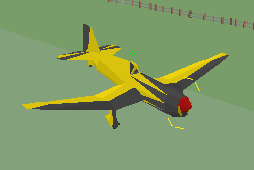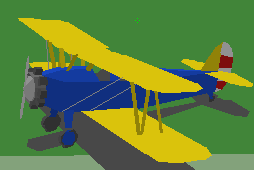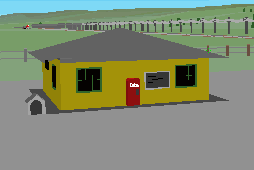 A 911-SR racing
plane, on base leg into Chaplin Field. This fictitous design
is reminiscent of classic air racers of the 1930's like the
Percival Gull. Powered by a 12 cylinder in line water cooled
engine, the 911 has inverted gull wings and widely spaced
fixed spatted undercarriage. The example shown here carries
the Scorpion Racing Team yellow and black colors. Be on the
look out for the new 911-SR-RE; rumoured to have retracting
undercarriage and a 1,000 HP radial engine.
A 911-SR racing
plane, on base leg into Chaplin Field. This fictitous design
is reminiscent of classic air racers of the 1930's like the
Percival Gull. Powered by a 12 cylinder in line water cooled
engine, the 911 has inverted gull wings and widely spaced
fixed spatted undercarriage. The example shown here carries
the Scorpion Racing Team yellow and black colors. Be on the
look out for the new 911-SR-RE; rumoured to have retracting
undercarriage and a 1,000 HP radial engine.
 Granville Brothers GEE BEE R2.
Perhaps the greatest racer of them all - the short stubby
winged GeeBee won air races and killed air racers with equal
ease. Best described as a mammoth radial engine attached to
the minimal amount of plane needed to fly it, the GeeBee's
were a handful for the unwary, but spectacularly fast. This
FST shape designed by Brian Ford and MouseByte7. Who IS
MouseByte7, really? Only The Shadow knows.....
Granville Brothers GEE BEE R2.
Perhaps the greatest racer of them all - the short stubby
winged GeeBee won air races and killed air racers with equal
ease. Best described as a mammoth radial engine attached to
the minimal amount of plane needed to fly it, the GeeBee's
were a handful for the unwary, but spectacularly fast. This
FST shape designed by Brian Ford and MouseByte7. Who IS
MouseByte7, really? Only The Shadow knows.....
 Boeing P-26A "Peashooter".
Frontline fighter for the US Army Aircorps in the 1930's, the
"Peashooter" was state of the art for its time.
Seen here in green and yellow paint, the P-26's were decked
out in a variety of eye-catching color schemes, often with
spectacular unit insignia. Although outdated when WW2 broke
out, some were on hand in Hawaii when Pearl Harbour was
attacked, and a few others on the Philipines were actually
used against the Japanese by courageous Philipino pilots.
Boeing P-26A "Peashooter".
Frontline fighter for the US Army Aircorps in the 1930's, the
"Peashooter" was state of the art for its time.
Seen here in green and yellow paint, the P-26's were decked
out in a variety of eye-catching color schemes, often with
spectacular unit insignia. Although outdated when WW2 broke
out, some were on hand in Hawaii when Pearl Harbour was
attacked, and a few others on the Philipines were actually
used against the Japanese by courageous Philipino pilots.
 Polikarpov I-16. One of the
first low wing monoplane fighters to enter service, the tubby
I-16 was a sensation in its day, with high speed from its
powerful radial engine. It featured hand operated retracting
undercarriage. The type saw extensive service - in the
Spanish Civil War on both sides, in Chinese hands against the
Japanese over Manchuria, and even in WW2 it was flown by
plucky Soviet pilots against superior Luftwaffe aircraft.
Polikarpov I-16. One of the
first low wing monoplane fighters to enter service, the tubby
I-16 was a sensation in its day, with high speed from its
powerful radial engine. It featured hand operated retracting
undercarriage. The type saw extensive service - in the
Spanish Civil War on both sides, in Chinese hands against the
Japanese over Manchuria, and even in WW2 it was flown by
plucky Soviet pilots against superior Luftwaffe aircraft.
 A Boeing/Stearman Model 75
is seen on the grass at Chaplin Field, near the refueling
bays. This famous two seat trainer gave thousands of American
pilots their wings. Also know as the PT-13 or PT-17 and
sometimes by the name "Kaydet", these durable
rugged aircraft still live on today, often as crop dusters.
A Boeing/Stearman Model 75
is seen on the grass at Chaplin Field, near the refueling
bays. This famous two seat trainer gave thousands of American
pilots their wings. Also know as the PT-13 or PT-17 and
sometimes by the name "Kaydet", these durable
rugged aircraft still live on today, often as crop dusters.
 A Douglas DC-2 pauses at
Chaplin Field on a stopover to Franklin. The DC-2 and
slightly larger DC-3 are arguably the greatest aircraft ever
made, in respect to length of service and adaptability. These
all metal low wing airliners were fast, efficient and
reliable at a time when air travel was not, and made aviation
safer as well as profitable. Also known - in various guises -
as C-47's, "Dakotas" or just plain "Gooney
Birds" the DC-2's and 3's brought commercial avaiation
into its own.
A Douglas DC-2 pauses at
Chaplin Field on a stopover to Franklin. The DC-2 and
slightly larger DC-3 are arguably the greatest aircraft ever
made, in respect to length of service and adaptability. These
all metal low wing airliners were fast, efficient and
reliable at a time when air travel was not, and made aviation
safer as well as profitable. Also known - in various guises -
as C-47's, "Dakotas" or just plain "Gooney
Birds" the DC-2's and 3's brought commercial avaiation
into its own.
Not Just
Airplanes.... Buildings Too!
 When at Chaplin Field, stop by the airport
office located in this tidy bungalow. Have a cold
Coke from the machine, check the flight schedules on the
chalkboard, and give Rex a pat if he's in his kennel. Beyond
the boundary fence thats Curtis Road, lined by telephone
poles, that leads towards the town of Colbert. The bus will
be along any minute, unless Clayton has let his watch run
down again. No matter.. gives you more time to watch the
airplanes.
When at Chaplin Field, stop by the airport
office located in this tidy bungalow. Have a cold
Coke from the machine, check the flight schedules on the
chalkboard, and give Rex a pat if he's in his kennel. Beyond
the boundary fence thats Curtis Road, lined by telephone
poles, that leads towards the town of Colbert. The bus will
be along any minute, unless Clayton has let his watch run
down again. No matter.. gives you more time to watch the
airplanes.
 On the right, just off Curtis Road as you
leave Chaplin Field, stands lonely Bate's Mansion.
Young Norman Bates is quite sane, really... but his mother is
off her rocker. Why not stop by for coffee and cake, and a
chat with Norman about taxedermy? Relax if you like.. and
take a shower....
On the right, just off Curtis Road as you
leave Chaplin Field, stands lonely Bate's Mansion.
Young Norman Bates is quite sane, really... but his mother is
off her rocker. Why not stop by for coffee and cake, and a
chat with Norman about taxedermy? Relax if you like.. and
take a shower....
Yes, this really IS the house from the Alfred Hitchcock movie
PSYCHO. I made it from the plans of the Polar Lights model
kit that a friend happened to bring over for my perusal. Why?
well... all I can say is the urge came over me
suddenly.......
 Further along Curtis Road, we come to the Chaplin
First Presbyterian Church, complete with open tower
and bell. Reverend McIeod has politely requested that planes
from Chaplin do not buzz the steeple, especially on Sundays.
The plane that took this photo for us is about to need a dose
of divine invertention, considering the close proximity of
the telephone wires in the foreground. There is a small stone
walled cemetary by the church where some of Chaplin's and
Colbert's oldest residences are interned for all time.
Further along Curtis Road, we come to the Chaplin
First Presbyterian Church, complete with open tower
and bell. Reverend McIeod has politely requested that planes
from Chaplin do not buzz the steeple, especially on Sundays.
The plane that took this photo for us is about to need a dose
of divine invertention, considering the close proximity of
the telephone wires in the foreground. There is a small stone
walled cemetary by the church where some of Chaplin's and
Colbert's oldest residences are interned for all time.
 "You can trust your car to the man
who wears a star.."
"You can trust your car to the man
who wears a star.."
Stop by the Chaplin Texaco Station and say
hi to Earl, the propietor. Earl is always ready and willing
to fill your tank, check your oil and tires, give directions,
or just fill you in with the latest exploits of those
"Damned crazy pilot fellas, from down the road..."
He carries a range of spares and accesories, roadmaps, drinks
and other refreshments, and if you need to use the phone
theres a blue Bell booth just around the corner of the
office.
 A Travelair
"Mystery" Ship buzzes the Texaco station
on Curtis Road. The travelair company was formed by Messrs
Beech and Stearman, both of whom went on to found lasting
aircraft dynasties in their own right. The
"Mystery" ship wowed the crowds and blitzed the
field at the 1933 Air Races, beating Army pursuit planes of
the day. It was one of the first planes to surpass the 200
mph barrier.
A Travelair
"Mystery" Ship buzzes the Texaco station
on Curtis Road. The travelair company was formed by Messrs
Beech and Stearman, both of whom went on to found lasting
aircraft dynasties in their own right. The
"Mystery" ship wowed the crowds and blitzed the
field at the 1933 Air Races, beating Army pursuit planes of
the day. It was one of the first planes to surpass the 200
mph barrier. A 911-SR racing
plane, on base leg into Chaplin Field. This fictitous design
is reminiscent of classic air racers of the 1930's like the
Percival Gull. Powered by a 12 cylinder in line water cooled
engine, the 911 has inverted gull wings and widely spaced
fixed spatted undercarriage. The example shown here carries
the Scorpion Racing Team yellow and black colors. Be on the
look out for the new 911-SR-RE; rumoured to have retracting
undercarriage and a 1,000 HP radial engine.
A 911-SR racing
plane, on base leg into Chaplin Field. This fictitous design
is reminiscent of classic air racers of the 1930's like the
Percival Gull. Powered by a 12 cylinder in line water cooled
engine, the 911 has inverted gull wings and widely spaced
fixed spatted undercarriage. The example shown here carries
the Scorpion Racing Team yellow and black colors. Be on the
look out for the new 911-SR-RE; rumoured to have retracting
undercarriage and a 1,000 HP radial engine. Granville Brothers GEE BEE R2.
Perhaps the greatest racer of them all - the short stubby
winged GeeBee won air races and killed air racers with equal
ease. Best described as a mammoth radial engine attached to
the minimal amount of plane needed to fly it, the GeeBee's
were a handful for the unwary, but spectacularly fast. This
FST shape designed by Brian Ford and MouseByte7. Who IS
MouseByte7, really? Only The Shadow knows.....
Granville Brothers GEE BEE R2.
Perhaps the greatest racer of them all - the short stubby
winged GeeBee won air races and killed air racers with equal
ease. Best described as a mammoth radial engine attached to
the minimal amount of plane needed to fly it, the GeeBee's
were a handful for the unwary, but spectacularly fast. This
FST shape designed by Brian Ford and MouseByte7. Who IS
MouseByte7, really? Only The Shadow knows..... Boeing P-26A "Peashooter".
Frontline fighter for the US Army Aircorps in the 1930's, the
"Peashooter" was state of the art for its time.
Seen here in green and yellow paint, the P-26's were decked
out in a variety of eye-catching color schemes, often with
spectacular unit insignia. Although outdated when WW2 broke
out, some were on hand in Hawaii when Pearl Harbour was
attacked, and a few others on the Philipines were actually
used against the Japanese by courageous Philipino pilots.
Boeing P-26A "Peashooter".
Frontline fighter for the US Army Aircorps in the 1930's, the
"Peashooter" was state of the art for its time.
Seen here in green and yellow paint, the P-26's were decked
out in a variety of eye-catching color schemes, often with
spectacular unit insignia. Although outdated when WW2 broke
out, some were on hand in Hawaii when Pearl Harbour was
attacked, and a few others on the Philipines were actually
used against the Japanese by courageous Philipino pilots. Polikarpov I-16. One of the
first low wing monoplane fighters to enter service, the tubby
I-16 was a sensation in its day, with high speed from its
powerful radial engine. It featured hand operated retracting
undercarriage. The type saw extensive service - in the
Spanish Civil War on both sides, in Chinese hands against the
Japanese over Manchuria, and even in WW2 it was flown by
plucky Soviet pilots against superior Luftwaffe aircraft.
Polikarpov I-16. One of the
first low wing monoplane fighters to enter service, the tubby
I-16 was a sensation in its day, with high speed from its
powerful radial engine. It featured hand operated retracting
undercarriage. The type saw extensive service - in the
Spanish Civil War on both sides, in Chinese hands against the
Japanese over Manchuria, and even in WW2 it was flown by
plucky Soviet pilots against superior Luftwaffe aircraft. A Boeing/Stearman Model 75
is seen on the grass at Chaplin Field, near the refueling
bays. This famous two seat trainer gave thousands of American
pilots their wings. Also know as the PT-13 or PT-17 and
sometimes by the name "Kaydet", these durable
rugged aircraft still live on today, often as crop dusters.
A Boeing/Stearman Model 75
is seen on the grass at Chaplin Field, near the refueling
bays. This famous two seat trainer gave thousands of American
pilots their wings. Also know as the PT-13 or PT-17 and
sometimes by the name "Kaydet", these durable
rugged aircraft still live on today, often as crop dusters. A Douglas DC-2 pauses at
Chaplin Field on a stopover to Franklin. The DC-2 and
slightly larger DC-3 are arguably the greatest aircraft ever
made, in respect to length of service and adaptability. These
all metal low wing airliners were fast, efficient and
reliable at a time when air travel was not, and made aviation
safer as well as profitable. Also known - in various guises -
as C-47's, "Dakotas" or just plain "Gooney
Birds" the DC-2's and 3's brought commercial avaiation
into its own.
A Douglas DC-2 pauses at
Chaplin Field on a stopover to Franklin. The DC-2 and
slightly larger DC-3 are arguably the greatest aircraft ever
made, in respect to length of service and adaptability. These
all metal low wing airliners were fast, efficient and
reliable at a time when air travel was not, and made aviation
safer as well as profitable. Also known - in various guises -
as C-47's, "Dakotas" or just plain "Gooney
Birds" the DC-2's and 3's brought commercial avaiation
into its own. When at Chaplin Field, stop by the airport
office located in this tidy bungalow. Have a cold
Coke from the machine, check the flight schedules on the
chalkboard, and give Rex a pat if he's in his kennel. Beyond
the boundary fence thats Curtis Road, lined by telephone
poles, that leads towards the town of Colbert. The bus will
be along any minute, unless Clayton has let his watch run
down again. No matter.. gives you more time to watch the
airplanes.
When at Chaplin Field, stop by the airport
office located in this tidy bungalow. Have a cold
Coke from the machine, check the flight schedules on the
chalkboard, and give Rex a pat if he's in his kennel. Beyond
the boundary fence thats Curtis Road, lined by telephone
poles, that leads towards the town of Colbert. The bus will
be along any minute, unless Clayton has let his watch run
down again. No matter.. gives you more time to watch the
airplanes. On the right, just off Curtis Road as you
leave Chaplin Field, stands lonely Bate's Mansion.
Young Norman Bates is quite sane, really... but his mother is
off her rocker. Why not stop by for coffee and cake, and a
chat with Norman about taxedermy? Relax if you like.. and
take a shower....
On the right, just off Curtis Road as you
leave Chaplin Field, stands lonely Bate's Mansion.
Young Norman Bates is quite sane, really... but his mother is
off her rocker. Why not stop by for coffee and cake, and a
chat with Norman about taxedermy? Relax if you like.. and
take a shower.... Further along Curtis Road, we come to the Chaplin
First Presbyterian Church, complete with open tower
and bell. Reverend McIeod has politely requested that planes
from Chaplin do not buzz the steeple, especially on Sundays.
The plane that took this photo for us is about to need a dose
of divine invertention, considering the close proximity of
the telephone wires in the foreground. There is a small stone
walled cemetary by the church where some of Chaplin's and
Colbert's oldest residences are interned for all time.
Further along Curtis Road, we come to the Chaplin
First Presbyterian Church, complete with open tower
and bell. Reverend McIeod has politely requested that planes
from Chaplin do not buzz the steeple, especially on Sundays.
The plane that took this photo for us is about to need a dose
of divine invertention, considering the close proximity of
the telephone wires in the foreground. There is a small stone
walled cemetary by the church where some of Chaplin's and
Colbert's oldest residences are interned for all time. "You can trust your car to the man
who wears a star.."
"You can trust your car to the man
who wears a star.."